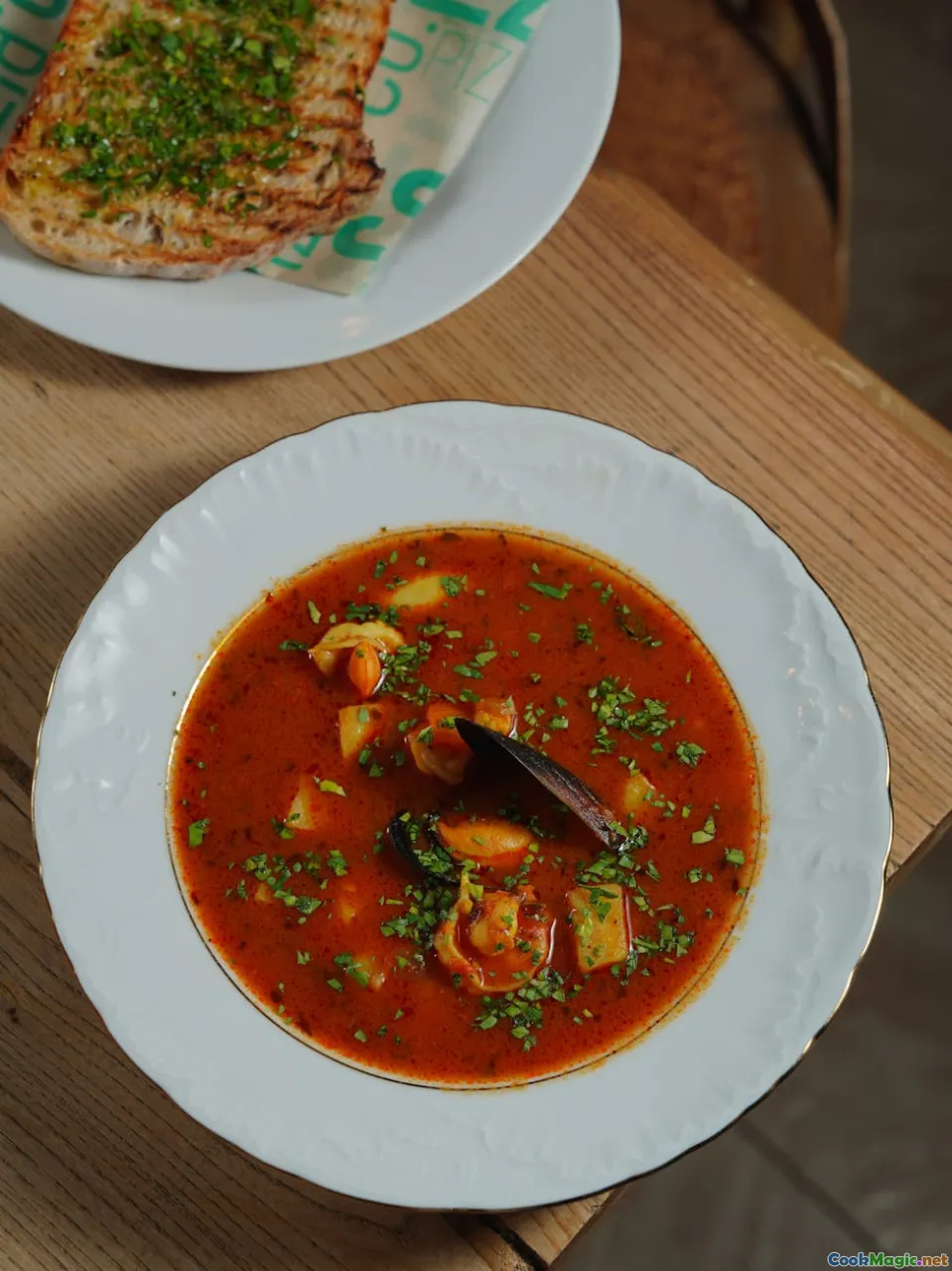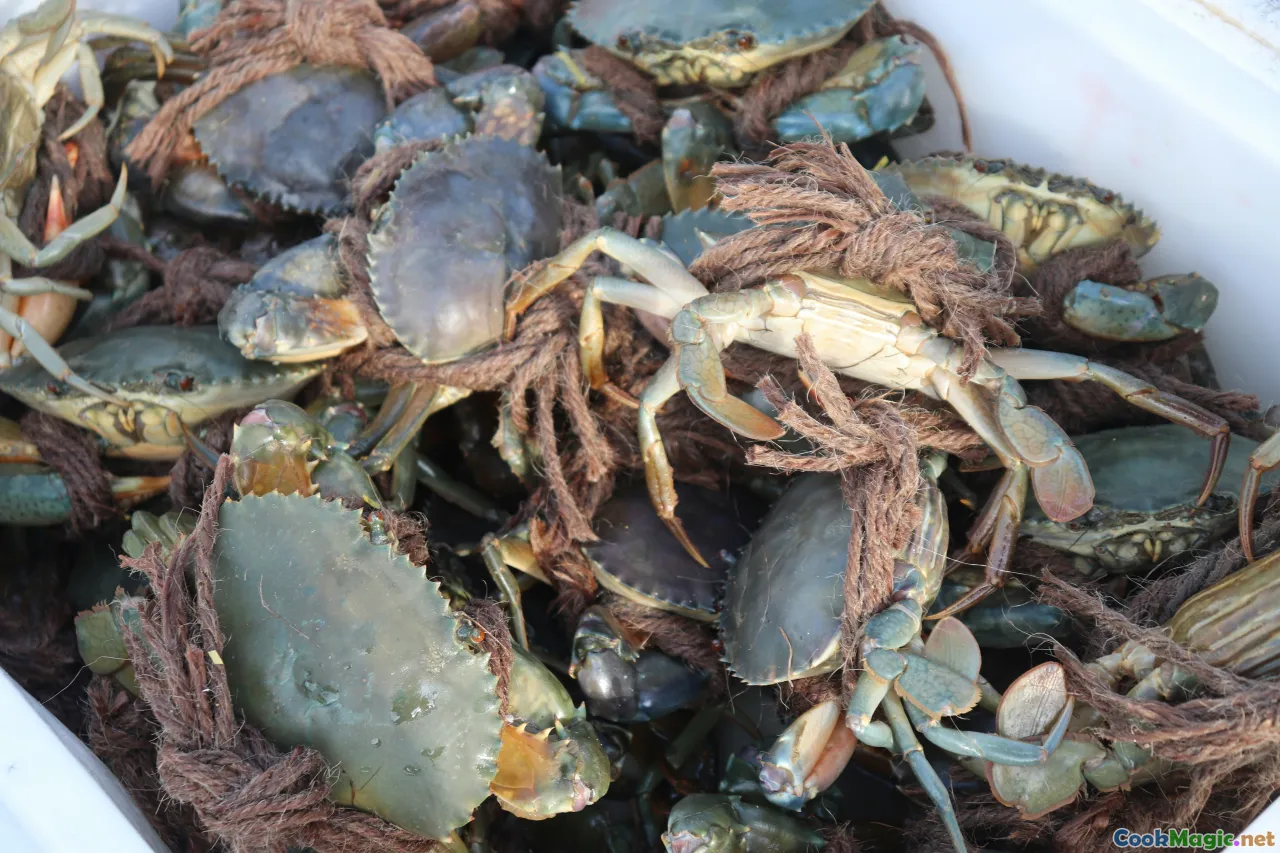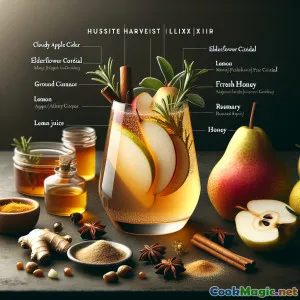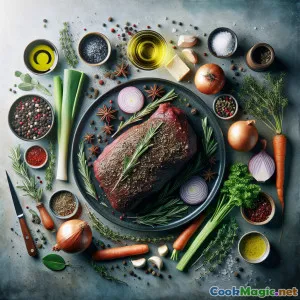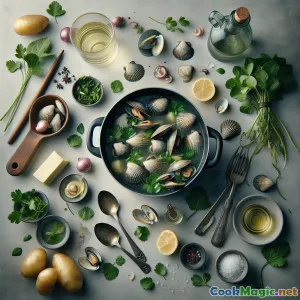
艾草蛤蜊汤:英式海岸风味
(Mugwort Clam Soup: An English Coastal Twist)
(0 评论)食材
-
500 grams 新鲜蛤蜊
(彻底清洗干净;littleneck 蛤蜊或英国本地蛤蜊。)
-
20 grams 新鲜艾草叶
(仅选用年轻嫩叶。清洗后切碎。)
-
2 medium 青葱
(切得很细)
-
100 ml 干白葡萄酒
(最好使用英国产的白葡萄酒。)
-
20 grams 无盐黄油
(增加丰富度。可以用油替代。)
-
500 ml 水或鱼汤
(优质鱼汤为首选。)
-
1 small (approx. 80g) 土豆
(去皮,切丁。像 Charlotte 推荐的那样,具有蜡质感。)
-
1 small handful 新鲜欧芹
(切碎,用于收尾。)
-
1 tsp 盐
(尝味;请小心调整。)
-
0.5 tsp 现磨黑胡椒
(根据口味。)
-
0.5 tsp 柠檬皮
(新鲜磨碎;可选的明亮收尾。)
(彻底清洗干净;littleneck 蛤蜊或英国本地蛤蜊。)
(仅选用年轻嫩叶。清洗后切碎。)
(切得很细)
(最好使用英国产的白葡萄酒。)
(增加丰富度。可以用油替代。)
(优质鱼汤为首选。)
(去皮,切丁。像 Charlotte 推荐的那样,具有蜡质感。)
(切碎,用于收尾。)
(尝味;请小心调整。)
(根据口味。)
(新鲜磨碎;可选的明亮收尾。)
营养
- 份量: 2
- 每份大小: 1碗(350毫升)
- Calories: 320 kcal
- Carbohydrates: 25 g
- Protein: 21 g
- Fat: 10 g
- Fiber: 3 g
- Sugar: 2 g
- Sodium: 760 mg
- Cholesterol: 32 mg
- Calcium: 135 mg
- Iron: 11.2 mg
制作步骤
-
1 - 刷洗蛤蜊并备好:
在流水下刷洗新鲜的蛤蜊。丢弃开口的或有损坏的。放入加盐的水中浸泡20分钟,沥干并冲洗以去除砂粒。
-
2 - 开始煸香配料:
在锅中,用中火融化黄油。加入切丁的红葱头和一撮盐。用小火煮3–4分钟,直到软而透明,但不要上色。
-
3 - 加入土豆并去锅底的焦香残渣:
若使用,请加入切成丁的土豆并搅拌1分钟。倒入白葡萄酒,刮锅并让酒精蒸发2分钟。
-
4 - 加入高汤并小火慢炖:
加入水或鱼汤。用小火慢煨至轻微沸腾后,煮6–7分钟,直到土豆刚好变软。如果省略土豆,煮4分钟。
-
5 - 蛤蜊和艾草:
将清洗干净的蛤蜊和大部分切碎的艾蒿放入锅中(留出少量用于装饰)。盖上锅盖,3–5分钟内煮熟,偶尔摇动锅子,直到所有蛤蜊张开。取出并丢弃任何未张开的蛤蜊。
-
6 - 完成和调味:
拌入保留的艾叶、切碎的欧芹、黑胡椒、盐适量,以及可选的柠檬皮屑。尝尝味道并调整调味。
-
7 - 上菜:
把汤和蛤蜊盛入碗中。再撒上额外的欧芹,趁热享用,理想情况下配上优质的英国面包。
在流水下刷洗新鲜的蛤蜊。丢弃开口的或有损坏的。放入加盐的水中浸泡20分钟,沥干并冲洗以去除砂粒。
在锅中,用中火融化黄油。加入切丁的红葱头和一撮盐。用小火煮3–4分钟,直到软而透明,但不要上色。
若使用,请加入切成丁的土豆并搅拌1分钟。倒入白葡萄酒,刮锅并让酒精蒸发2分钟。
加入水或鱼汤。用小火慢煨至轻微沸腾后,煮6–7分钟,直到土豆刚好变软。如果省略土豆,煮4分钟。
将清洗干净的蛤蜊和大部分切碎的艾蒿放入锅中(留出少量用于装饰)。盖上锅盖,3–5分钟内煮熟,偶尔摇动锅子,直到所有蛤蜊张开。取出并丢弃任何未张开的蛤蜊。
拌入保留的艾叶、切碎的欧芹、黑胡椒、盐适量,以及可选的柠檬皮屑。尝尝味道并调整调味。
把汤和蛤蜊盛入碗中。再撒上额外的欧芹,趁热享用,理想情况下配上优质的英国面包。
关于 艾草蛤蜊汤:英式海岸风味 :的更多信息
Mugwort Clam Soup: Ancient Greens, Coastal Bounty
Mugwort Clam Soup marries earthy woodland herbs with the bounty of the English coast for a wonderful, unusual dish that bridges tradition and modern English cookery.
History & Cultural Significance
Clam dishes have long featured in British coastal kitchens; native species like palourde or common cockle have provided rich nutrition for centuries. Adding mugwort introduces even deeper heritage: mugwort (Artemisia vulgaris), ubiquitous along hedgerows, fields, and riverbanks in the British Isles, served as both seasoning and medicinal herb for millennia. Historically, mugwort was prized for its digestive, tonic, and slightly bitter notes. Old English and Celtic gastronomy made liberal use of wild greens like mugwort, especially in spring for restorative dishes.
Though mugwort was traditionally added to stuffings and game or brewed in teas, its aromatic profile resonates with shellfish, subtly lending earth, bittersweet, and even anise-like undertones to seafood broths. Mugwort complements the salinity and delicacy of British clams surprisingly well, producing a soup at once ancient and modern.
Unique Aspects & Tips
- Selecting Mugwort: Use only the youngest mugwort leaves for the soup; older leaves may be fibrous. Mugwort is assertive so use sparingly until you appreciate its aromatic punch.
- Clams: Little English clams (like the palourdes of Cornwall or Scottish waters) are sweetest in late spring. Ensure they are spotless—traditional advice includes soaking in salty water to draw out sand.
- Broth: English dry white wine lifts the broth, while any coastal fish stock deepens seafood resonance. Chicken or vegetable stock works in a pinch but avoid overpowering the subtle herbs.
- Variations: Try with cockles or mussels if clams are unavailable. Add a dash of double cream for a nod to classic chowder or toss in wild leeks in early spring for even greater fragrance.
- Pairing: Serve with a hearty soda bread or a slice of nutty malted sourdough. To drink, a crisp English white wine or even non-alcoholic elderflower cordial complements herbal notes.
Final Thoughts
This Mugwort Clam Soup is a tribute to old English countryside foraging and the ever-present influence of the sea. The resultant bowl is fragrant, refreshing, briny, herbal, and slightly bitter—the kind of soup that surprises and satisfies palate and soul alike. Whether as a gentle supper to accompany the first sunny British days of spring or the anchor dish of a sophisticated dinner, this recipe connects you to centuries of herbcraft and seashore cookery. Mugwort is increasingly celebrated by modern British chefs; here, it shines as the signature green, with every bite evocative of brisk coastal walks and nostalgic stews.
Be bold in venturing beyond the familiar as English cuisine continues to revive ancient ingredients. The distinctive union of mugwort and clams proves that some remarkable combinations await in overlooked hedgerows and tidal beds—affirming the curiosity and adaptability at the heart of English food. Happy foraging, and enjoy your unique bowlful of Mugwort Clam Soup!

